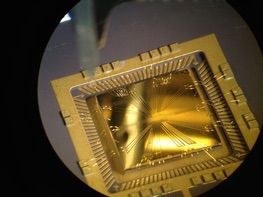SCIENCE
Gold chip ion-trap captures Science Photography Competition's top prize

An image of a gold chip used to trap ions for use in quantum supercomputing has won the overall prize in a national science photography competition, organised by the Engineering and Physical Sciences Research Council (EPSRC).
'Microwave ion-trap chip for quantum computation', by Diana Prado Lopes Aude Craik and Norbert Linke, from the University of Oxford, shows the chip's gold wire-bonds connected to electrodes which transmit electric fields to trap single atomic ions a mere 100 microns above the device's surface.
The image, taken through a microscope in one of the university's cleanrooms, came first in the Eureka category as well as winning overall against many other stunning pictures, featuring research in action, in the EPSRC competition - now in its third year.
Doctoral student Diana Prado Lopes Aude Craik, explained how the chip works: "When electric potentials are applied to the chip's gold electrodes, single atomic ions can be trapped. These ions are used as quantum bits ('qubits'), units which store and process information in a quantum computer. Two energy states of the ions act as the '0' and '1' states of these qubits. Slotted electrodes on the chip deliver microwave radiation to the ions, allowing us to manipulate the stored quantum information by exciting transitions between the '0' and '1' energy states.
"This device was micro-fabricated using photolithography, a technique similar to photographic film development. Gold wire-bonds connect the electrodes to pads around the device through which signals can be applied. You can see the wire-bonding needle in the top-left corner of the image. The Oxford team recently achieved the world's highest-performing qubits and quantum logic operations."
The development of the ion-trap chip was funded jointly by the EPSRC and the US Army Research Office.
The competition's five categories were: Eureka, Equipment, People, Innovation, and Weird and Wonderful. Winning images feature:
- A spectacular 9.5 metre wave created to wow crowds at the FloWave Ocean Energy Research Facility at the University of Edinburgh
- An iCub humanoid robot learning about how to play from a baby as part of robotics research taking place at Aberystwyth University
- The intense, blinding light of plasma formed by an ultrafast laser being used to process glass at the EPSRC Centre for Innovative Manufacturing in Ultra Precision at the University of Cambridge
- A beautiful rotating jet of viscoelastic liquid water resembling a spinning dancer that demonstrates the effect of adding a tiny amount of polymer to water and an example of fluid dynamics research at Imperial College London
One of the judges was Professor Robert Winston, he said: "It is crucial to promote greater understanding of science and engineering research, the role it plays in making new discoveries, developing new technologies and in making the world a better place for us all. These are truly inspirational images and tell great stories. It was a real pleasure to take part as a judge and I hope people will want to find out more."
Congratulating the winners and entrants, Professor Philip Nelson, EPSRC's Chief Executive, said: "Yet again, the standard of entries into this year's competition shows the inquisitive, artistic and perceptive nature of the people EPSRC supports. I'd like to thank everyone who entered; you made judging a very hard but enjoyable task.
"This competition helps us engage with academics and these stunning images are a great way to connect the general public with research they fund, and inspire everyone to take an interest in science and engineering."
The competition received over 200 entries which were drawn from researchers in receipt of EPSRC funding.
The judges were:
Martin Keene - Group Picture Editor - Press Association;
Professor Robert Winston - Professor of Science and Society and Emeritus Professor of Fertility Studies at Imperial College London
Professor Philip Nelson - EPSRC's Chief Executive
The first, second and third prize winning images with descriptions are all available to download from the EPSRC website http://www.

